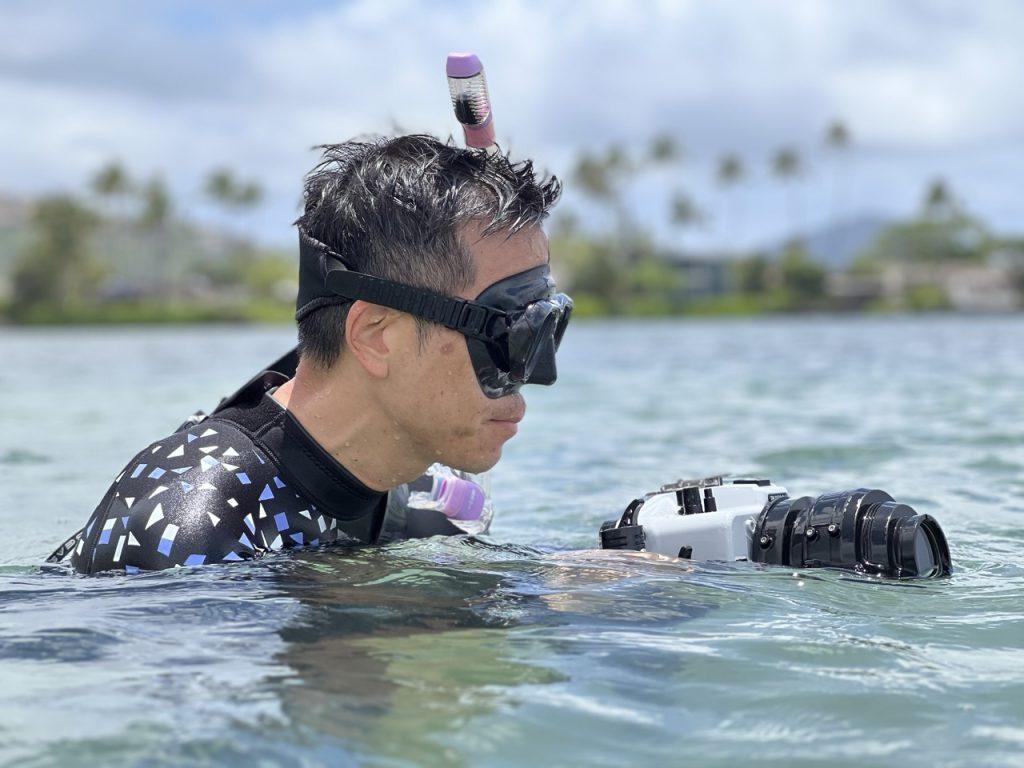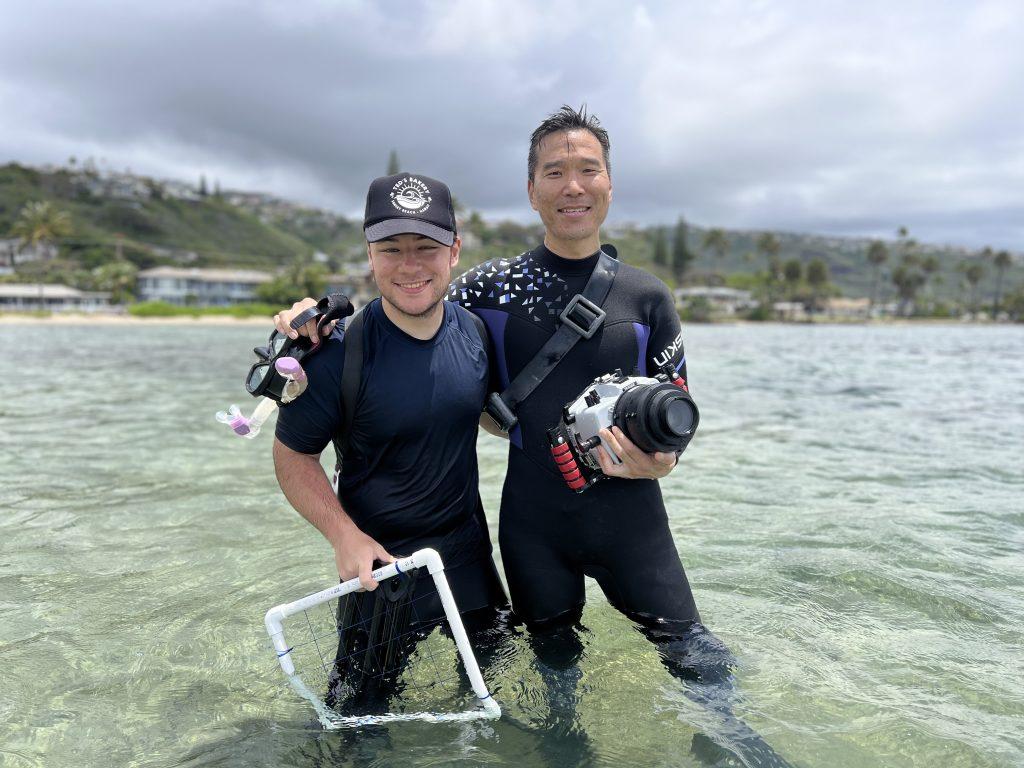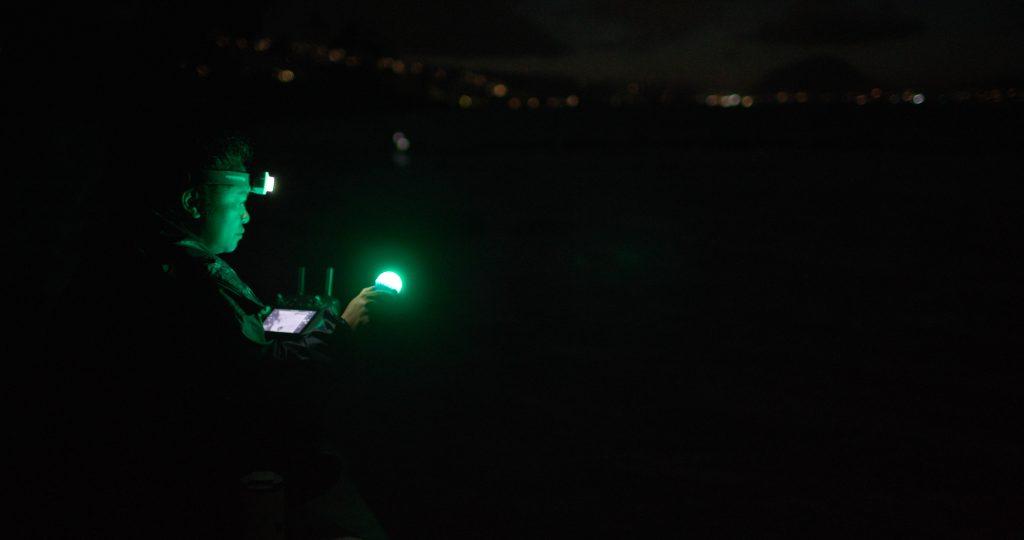
Screen Arts Professor Paul B. Kim spent a week of his summer in Hawai’i, directly aligned with his philosophy for filmmaking. When encountering a new project, he said he thinks primarily about power and representation while trying to explore underrepresented spaces.
Kim and Nick Yi, senior Screen Arts major, stayed in Oahu, Hawai’i in May and spent eight days filming with Assistant Professor of Biology Florybeth La Valle‘s research team on their study of algae.
“I think a lot about, ‘How does one thoughtfully, meaningfully using their privilege with the camera, with the expertise in media and storytelling that they have, how do they come into an environment and tell the story about someone and or a community or a culture in a way that’s both balanced, equitable and just strengthens a community?'” Kim said.
Kim said he and La Valle started at Pepperdine around the same time. The two had a lot in common right off the bat, and he admired her perspective on science.
“I found that she cares a lot about science communication and recognizes that one of the challenges of science isn’t just in doing great research, but how do we make that research really relevant to our intended audience or to the general public,” Kim said.
As the two got to know one another, they realized their work philosophies have things in common. Though their fields use different terminology, Kim said he realized they shared a common vision.
“I just realized there’s this really interesting overlap in our philosophical approach to how we want to engage with the people that we work with in these community spaces,” Kim said. “So it was just this natural fit.”
Bringing on Staff
Around March, Kim reached out to Yi, one of his students. Yi said he remembers Kim contacting him with a “mysterious opportunity.”
Several phone calls and email exchanges later, Kim decided Yi was a good fit for the project.
“I was looking for somebody who would be really sensitive to the thoughtful nuances we would explore,” Kim said. “Nick took the introductory production class with me, and he was just a standout student in terms of his talents and his creative capacities.”

Kim said he is always looking to give his students opportunities they wouldn’t be able to find elsewhere, but with that comes great risk. If the student with the wrong skill set was brought on, the project might suffer.
Yi said he greatly admires Kim’s work and accolades within the film world, so being asked to be a part of this project made him feel both honored and nervous.
“I mean, it’s imposter syndrome, right?” Yi said. “You don’t really think you’re good enough to be asked by a professor to go and do something like this just with them, but it feels good. I feel proud of what we accomplished.”
Kim said he wanted Yi to know it was not a high stakes environment, though that was easy for him to say. He presumed Yi felt a tremendous amount of pressure being thrown into the deep end — both in terms of his duties behind the camera and literally, as they filmed several scenes in the ocean.
Yi described his role as “co-director slash everything else,” as Kim was primarily behind the camera and Yi assisted him with whatever he needed at any given moment.
“It’s just this very dynamic lab where we have to hit the ground running, learn quickly and do the best we can do to gather high-quality material that’s going to tell a story,” Kim said.
The Research

La Valle said she has been working in Maunalua Bay for over 10 years. When she came to Pepperdine, she got a National Science Foundation grant — the work would support what she did after her dissertation, which looked at high nutrients in fresh water coming into a coral reef as submarine groundwater discharge, and how it was affecting the wildlife that were there.
La Valle went to graduate school at the University of Hawai’i at Manoa, where she decided to look at drivers of coastal community changes. She said that in Hawai’i, place-based science is vital to the ecosystem.
“Hawai’i is a really special place, and the values of the people there all revolve around being at peace with the land,” La Valle said. “And so the idea of place-based science is — wherever your place is, wherever you’re located, can you observe nature there? And can you make hypotheses based off of those things?”
La Valle met Kanoe Morishige, the Native Hawaiian Program Specialist and National Oceanic and Atmospheric Administration Affiliate for Papahānaumokuākea Marine National Monument, during her time in graduate school. Their research focuses on “limu,” which is the Native Hawaiian word for algae. La Valle described her and Morishige’s shared emphasis on benefiting the community and keeping them in mind through the research process.
“The questions being answered should be based off of what the community is interested in,” La Valle said. “You have to create relationships with the community. They have to trust you, and then you can do your work. Every step of the way is a co-creation process.”
Kim emphasized the idea that he and Yi integrated themselves into La Valle and her team’s research and schedule. In most documentaries, directors have an agenda and everyone else sticks to that. Yet, in this case, Kim said he and Yi thoughtfully and carefully embedded themselves into the research being done.
La Valle furthered these sentiments, as she said bringing others into this kind of work can be difficult.
“I hold these communities that I work with really close and dear to my heart,” La Valle said. “So I wouldn’t have brought an outsider, so to speak, if I didn’t trust them — and I think that speaks volumes that, you know, I trust Professor Kim this much to actually have him come in.”
Yi said aside from all the great hands-on experience he got in working with Kim, the whole experience also opened his eyes up to a new world and perspective of science.
“It’s not really something you see on the mainland, this idea of place-based science and research,” Yi said. “Whatever science or research you do has to benefit the community in some way. You have to share your results and interact with them meaningfully. It really opened my eyes up — it was really special.”
Kim said he recognized the importance of La Valle’s research and emphasized that this was at the center of the documentary.
“I’m not thinking about my work simply in terms of, ‘How can I tell an entertaining story and get it out there?'” Kim said.
Looking Ahead
Kim said he had to navigate several difficulties throughout the trip, whether it was bad weather, choppy waves or needing a wetsuit. Despite these setbacks, he said he finds challenges to be exciting, always looking for ways to solve new problems.
“I see it as the purest forms of cinema: a camera, somebody performing some activity,” Kim said. “And we’re just capturing this kind of magic.”
Kim and Yi said they are now in the editing process with the documentary, which is no easy task.
“It’s almost like learning how to write a language, a new language — a cinematic language,” Kim said.
As for La Valle, she said she is roughly halfway through the grant. This summer, La Valle and her team are going to collect more data, and the grant will end in August 2026.
Yi reflected on the experience as an amazing learning opportunity, especially when looking ahead to his future. He said right now, his likely future trajectory aims at being an editor.
“The best way to learn is to just do it,” Yi said.
Kim said he hopes to have the documentary done by the end of the school year, though the official release date depends upon a number of factors. He is now looking into various film festivals, which can heavily alter the projected release date.
La Valle said she’s aware she could write a paper about her research or share her findings in other ways. Yet, she said she knows the work being done in conjunction with Kim’s documentary will spread her research further, especially to the communities who deserve to see it.
Kim said above all, he wants the audience to gain something from the message the documentary conveys.
“I’ve never heard of this type of work [in academia] and this approach of place-based science, which is what Dr. La Valle calls it. Scientific work that is committed to a local space and place with people who have needs and concerns,” Kim said. “I think that’s compelling. I think the world has not had that conversation and I want people to be aware of what’s going on.”
_________________________________
Follow the Graphic on X: @PeppGraphic
Contact Amanda Monahan via email: amanda.monahan@pepperdine.edu

